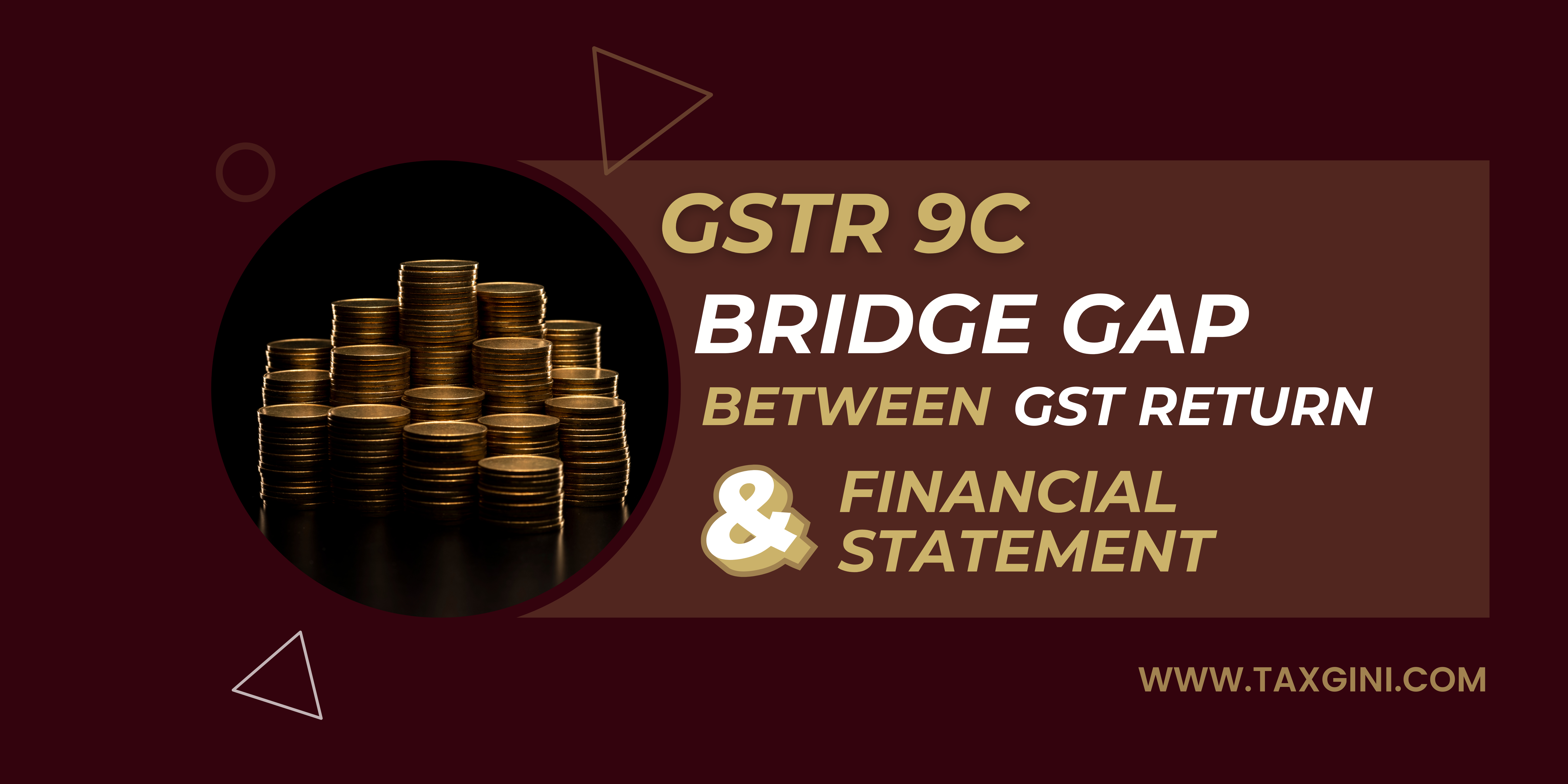Search
-
Navigating ITR 4: Unraveling Tax Complexity for Small Businesses
-
Form 26 AS Decoded: Your Key to Easy Income Tax Filing
-
Decoding Section 43B(h): A Game Changer for MSMEs and Businesses in India
-
ITR-3 Decoded: Get All Your Questions Answered Here!
-
From Panic to Profit: ITR-2 Made Easy for Stress-Free Tax Season
GSTR 9C Explained: Bridging the Gap Between GST Returns and Financial Statements
GSTR 9C is a form that is essential for taxpayers who have a certain turnover threshold. It was first introduced in India under the Goods and Services Tax (GST) regime. It is crucial to comprehend the purpose of this form in order to ensure compliance and prevent penalties.
What is GSTR 9C?
GSTR 9C, formally known as the “Annual Reconciliation Statement for Taxpayers with Turnover exceeding Rs. 5 Crore,” acts as a bridge between two important documents:
- Annual GST Returns (GSTR 9): This form summarises the total income and expenditure for the year, along with the tax liability.
- Audited Financial Statements: These statements, prepared by a Chartered Accountant, offer a detailed and independent evaluation of a company’s financial position.
It reconciles the figures declared in both documents, ensuring consistency and transparency
Who Needs to File GSTR 9C?
The requirement to file GSTR 9C applies to specific categories of taxpayers:
- Businesses with an annual aggregate turnover exceeding Rs. 5 crore.
- Taxpayers opting for the composition scheme with an annual turnover exceeding Rs. 1 crore.
- Non-resident taxable persons.
- Input Service Distributors (ISDs).
When is the Due Date for Filing GSTR 9C?
The due date for filing GSTR 9C is typically 31st December of the succeeding financial year. However, it’s best to stay updated on any potential changes or extensions announced by the GST authorities.
What does the form GSTR-9C contain?
There are two primary components to the GSTR-9C:
- Part-A: Reconciliation Statement
- Part-B: Self-Assessment
Part A: Reconciliation Statement:
This section serves as the heart of the GSTR-9C form. It reconciles various data points between your annual GST return (GSTR-9) and your audited financial statements. This includes:
- Income: Reconciling income from various sources like sales, interest income, and other income.
- Expenditure: Reconciling expenditure incurred on purchases, expenses, and other categories.
- Input Tax Credit (ITC): Reconciling the opening balance, ITC availed, ineligible ITC reversed, and closing balance.
- Output Tax Liability: Reconciling the tax liability declared in GSTR-9 with the actual liability calculated based on your audited financial statements.
- Tax Paid & Tax Payable: Reconciling the tax paid during the year with the actual tax paid and any outstanding tax payable or tax refunds claimed.
This section focuses on ensuring the accuracy and authenticity of the information provided in Part A. It includes:
- Declaration by the taxpayer: The taxpayer certifies the accuracy and completeness of the information presented in the form.
- Signatures and digital signatures: The taxpayer provide signatures and digital signatures for authentication.
These two components work together to ensure transparency and compliance with the Goods and Services Tax (GST) framework in India. The reconciliation statement provides a comprehensive overview of the financial activities, while the certification section verifies the authenticity of the information provided.
Benefits of Filing GSTR 9C:
- Reduced Errors & Penalties: Minimises discrepancies between returns and financial statements, lowering the risk of penalties.
- Enhanced Transparency: Demonstrates commitment to compliance, building trust with tax authorities.
- Simplified Audit Process: A well-prepared GSTR 9C facilitates a smoother audit process, saving time and resources.
- Improved Financial Management: By analysing reconciled data, businesses gain valuable insights into their financial health and identify areas for improvement.
Conclusion :
GSTR 9C, the annual GST reconciliation statement, plays a pivotal role in fostering transparency and compliance within the Goods and Services Tax (GST) framework in India. By bridging the gap between your annual GST return (GSTR 9) and your audited financial statements, this form serves as a vital tool for ensuring consistency and accuracy in reporting.
By understanding the significance, components, and benefits of GSTR 9C, taxpayers can actively contribute to a transparent and compliant GST environment. Remember, proactive engagement and accurate filing are crucial for ensuring a smooth and successful GSTR 9C experience.
FAQs for GSTR 9C :
Is it possible to revise GSTR-9C?
There is currently no provision for revising Form GSTR-9C. As a result, taxpayers are urged to exercise extreme caution when filling out Form GSTR-9C and submitting it.
Should Form GSTR-9C be filed for each registration under the same PAN, state by state?
Yes, Form GSTR-9C must be submitted for each registration in each state. When the aggregate PAN-based turnover exceeds Rs.2 crore, every registered GSTIN with the same PAN is required to have its accounts audited and file Form GSTR-9C.
How is the aggregate turnover calculated for GSTR-9C?
Value of all (taxable supplies + exempted supplies + zero rated supplies + non-GST supplies) – (Taxes & Cess under GST Act + inward supplies +supplies under reverse charge) of a person with the same PAN (Permanent Account Number) across all his business entities in India.
What are the documents required for filing GSTR-9C?
- You will need the following documents to file GSTR-9C:
- Audited financial statements for FY 2022-23
- Annual return (GSTR-9) for FY 2022-23
- GST registration certificate
Will a Registered Person who only has exempted supplies of goods or services worth more than Rs. 2 crores be required to file Form GSTR 9C?
Even exempted supplies are included in the definition of ‘aggregate turnover’. As a result, even if a person is registered for GST and only makes exempted supplies, he must file Form GSTR 9C.

